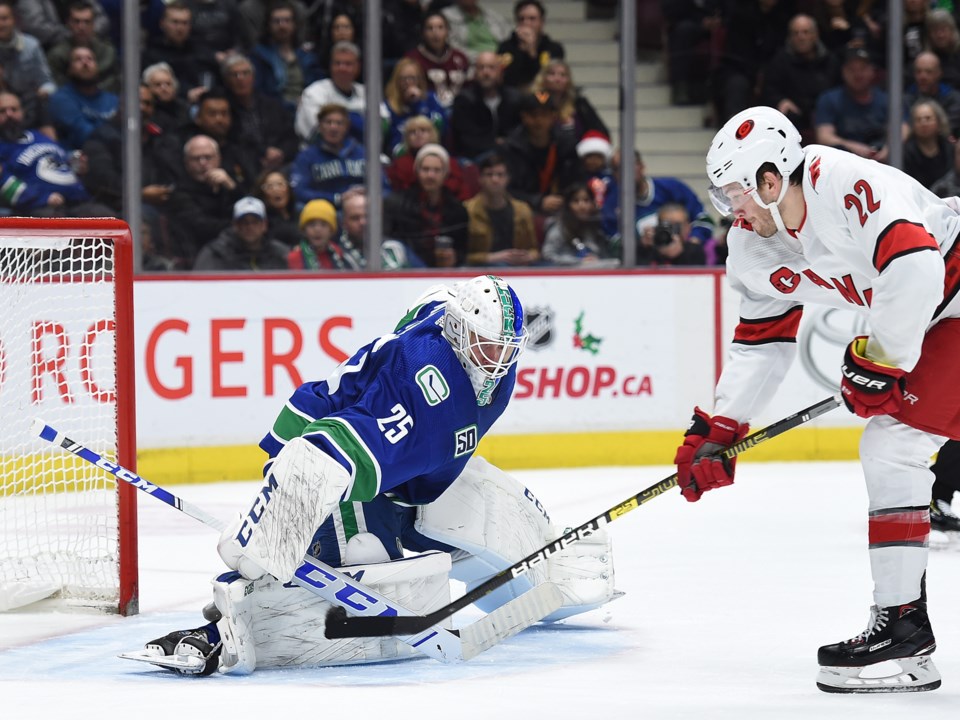Jacob Markstrom is having an unreal season.Őż
His save percentage of .915 ‚ÄĒ 14th among goaltenders with at least 20 starts ‚ÄĒ doesn‚Äôt fully tell the story of just how critical Markstrom has been to the Canucks. For that, you have to look at how the team has played defensively in front of him.
The Canucks have allowed the fourth-most shots per game this season, behind only the Chicago Blackhawks, New York Rangers and Ottawa Senators, and just ahead of the Detroit Red Wings. All four of those teams are well out of the playoffs, with the Senators in 29th in the NHL and the Red Wings in dead last, 11 points behind the next worst team.
Allowing that many shots against is usually a recipe for failure. Somehow, for the Canucks, it isn‚Äôt.Őż
It’s not just the quantity of shots; it’s the quality. According to analytics website Natural Stat Trick, the Canucks have allowed the third-most scoring chances against at five on five in the NHL. The Canucks are not keeping shots to the outside; opposing teams are getting into the slot and racking up scoring chances.
Despite that, the Canucks still find themselves on top of the Pacific Division, primarily because Markstrom has been sensational at stopping scoring chances.
Former NHL goaltender Stephen Valiquette is currently a CEO of Clear Sight Analytics (CSA), which takes the tracking of scoring chances up a notch from the publically available data used by Natural Stat Trick. CSA includes additional information, like passing data, screens, deflections, and broken plays, to more accurately determine the likelihood of any given shot becoming a goal.
Valiquette recently shared the results of some of CSA’s proprietary work on Twitter, showing where the NHL’s goaltenders rank in Goals Saved Above Average (GSAA). In other words, how would an average goaltender perform while facing the same quality of shots?
Markstrom was at the top of the chart, with a 15.33 GSAA that was significantly higher than any other NHL goaltender. Once you take into account the screens he has battled through to track the puck, the broken plays he’s reacted to with lightning reflexes, and the back door plays where he has lunged across to make spectacular saves, Markstrom looks like the best goaltender in the entire NHL.
That’s great for the Canucks this season, who are in a solid position to make the playoffs for the first time in five years, but it leaves them in a quandary for the future. Markstrom is on the last year of his contract and is in line for a significant raise from his current $3.67 million cap hit.
That could make things sticky for next season, where the Canucks already have around $63.5 million committed to the $81.5 million salary cap. That doesn’t include performance bonuses for the likes of Elias Pettersson and Quinn Hughes, which will have to be carried over to next year, chipping off another chunk of cap space.
That doesn’t leave much room to re-sign Markstrom and fellow unrestricted free agents Chris Tanev and Josh Leivo, as well as restricted free agents Jake Virtanen, Adam Gaudette, Troy Stecher, and others. That cap space will disappear quickly.
Even more troubling is the 2021-22 season, when both Pettersson and Hughes will be in line for massive contracts. The issue isn’t just about getting Pettersson and Hughes signed, but having enough flexibility under the cap to improve the team around them.
That makes Markstrom’s next contract a crucial one. The Canucks can likely keep the cap hit reasonable with a longer-term deal, but those get dicey for goaltenders over 30, as we’ve seen from Sergei Bobrovsky’s disastrous first season of a seven-year, $70 million contract with the Florida Panthers. A short-term contract with a higher cap hit would make more sense for the Canucks, who have to be thinking of the Seattle expansion draft and the up-and-coming Thatcher Demko.
To make a higher cap hit work over the next couple years, however, would require some significant wheeling and dealing to clear cap space. And the better Markstrom performs, the bigger the challenge for GM Jim Benning and his management team.
Őż
Stick-Taps and Glove-Drops
- A tap of the stick to Daniel and Henrik Sedin, whose numbers were raised to the rafters of Rogers Arena on Wednesday night. We’ll never see their like in the NHL again.
- Further stick-taps to the Canucks organization, who perfectly handled the entire week with the Sedins, bringing back not only other legends whose numbers have been retired, but a whole host of Sedin teammates. The ceremonies were as classy as the Sedins themselves.
Őż
Big Numbers
- 36Őż Canucks prospect Tyler Madden continues to tear up the NCAA. He‚Äôs currently fourth in the nation with 36 points in 26 games and his 18 goals are tied for third.
- 24Őż Madden has been excellent, but you shouldn‚Äôt overlook his teammate and fellow Canucks prospect Aidan McDonough, who is sixth among NCAA freshmen with 24 points in 23 games. Scoring at a point-per-game pace as a freshman is impressive for a seventh-round draft pick.



